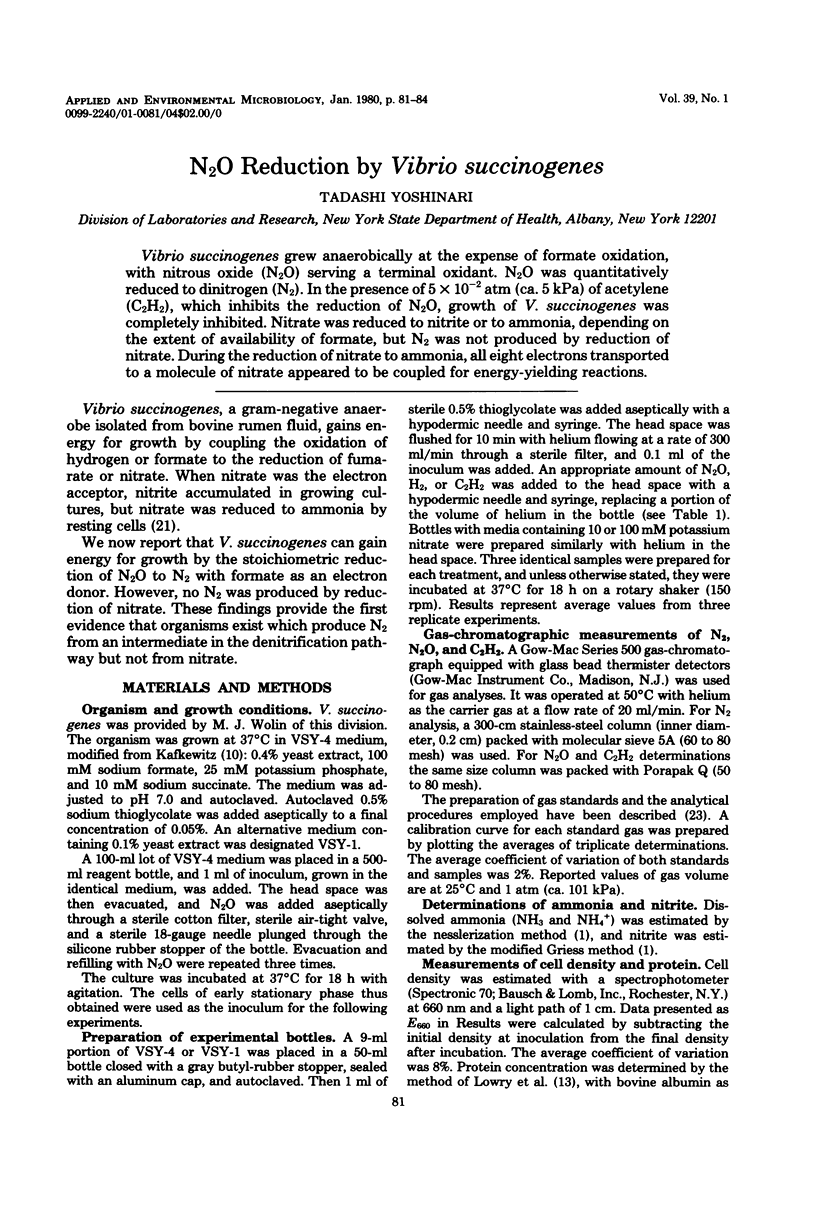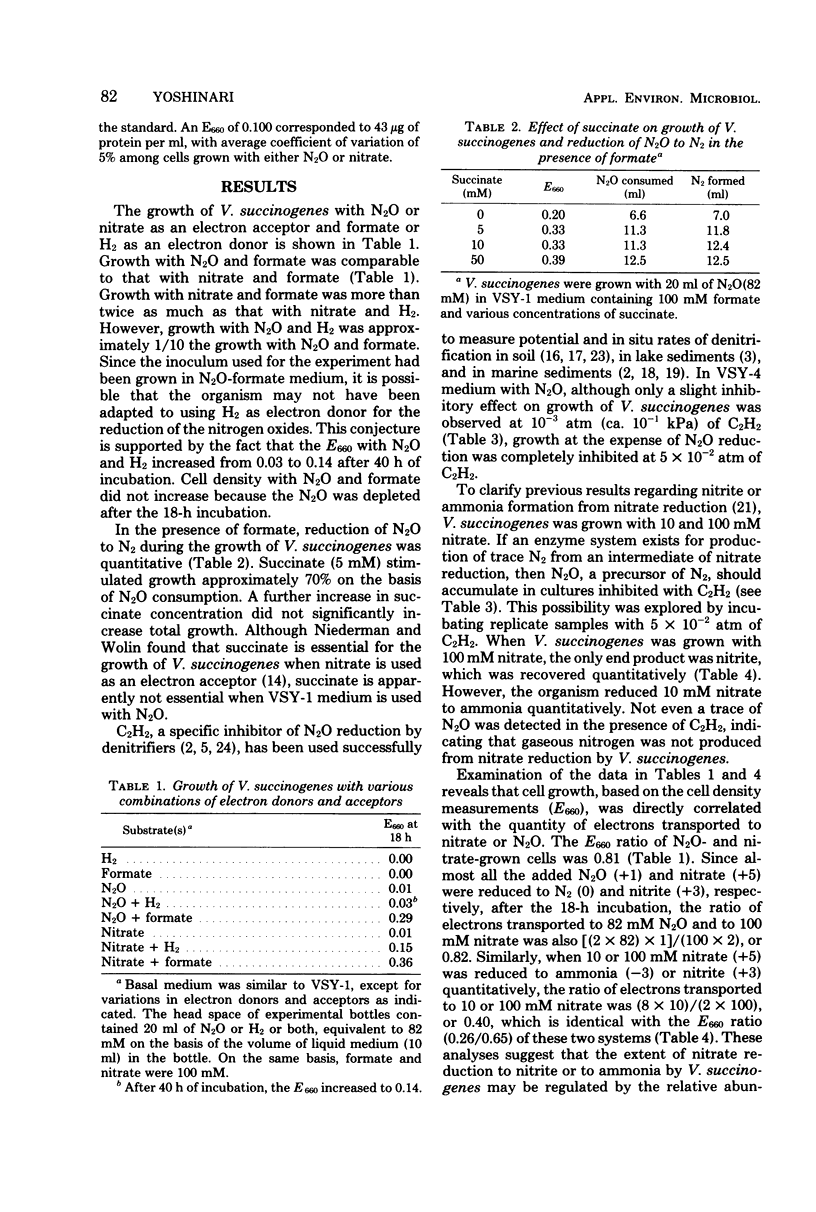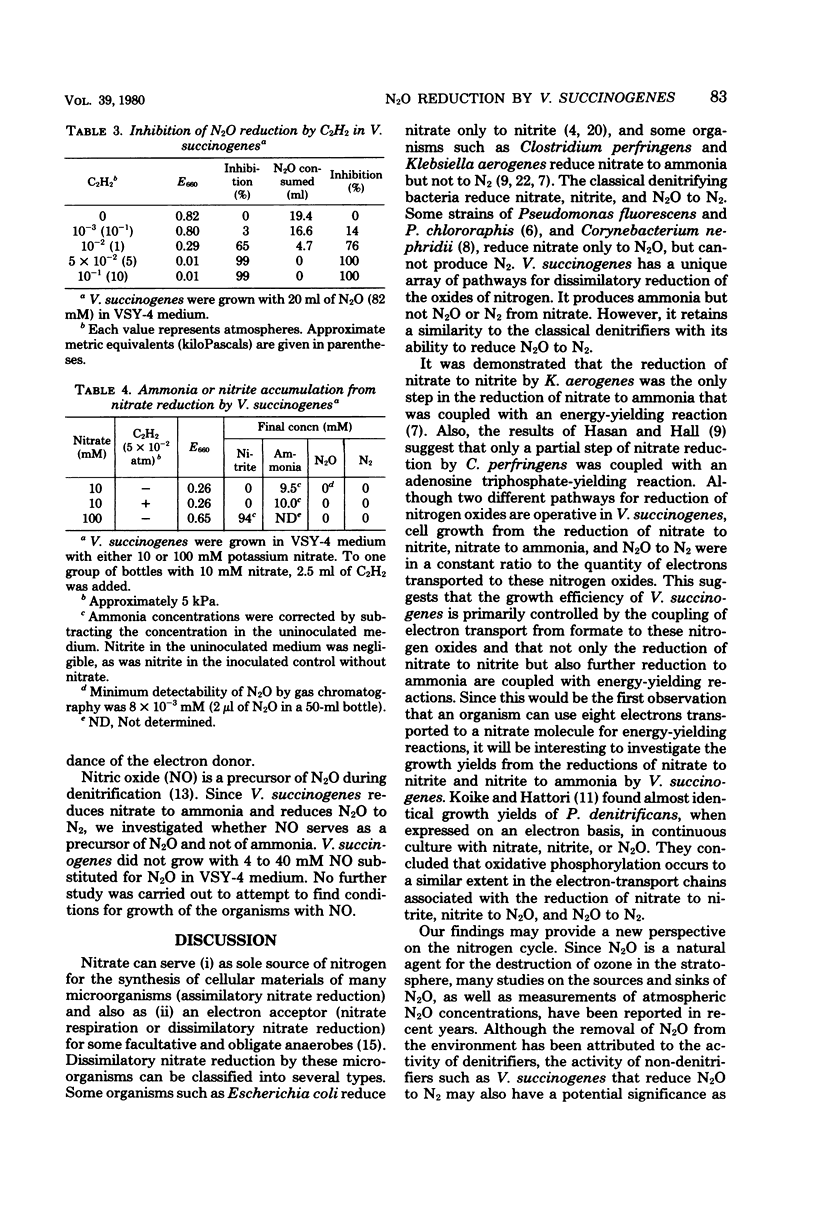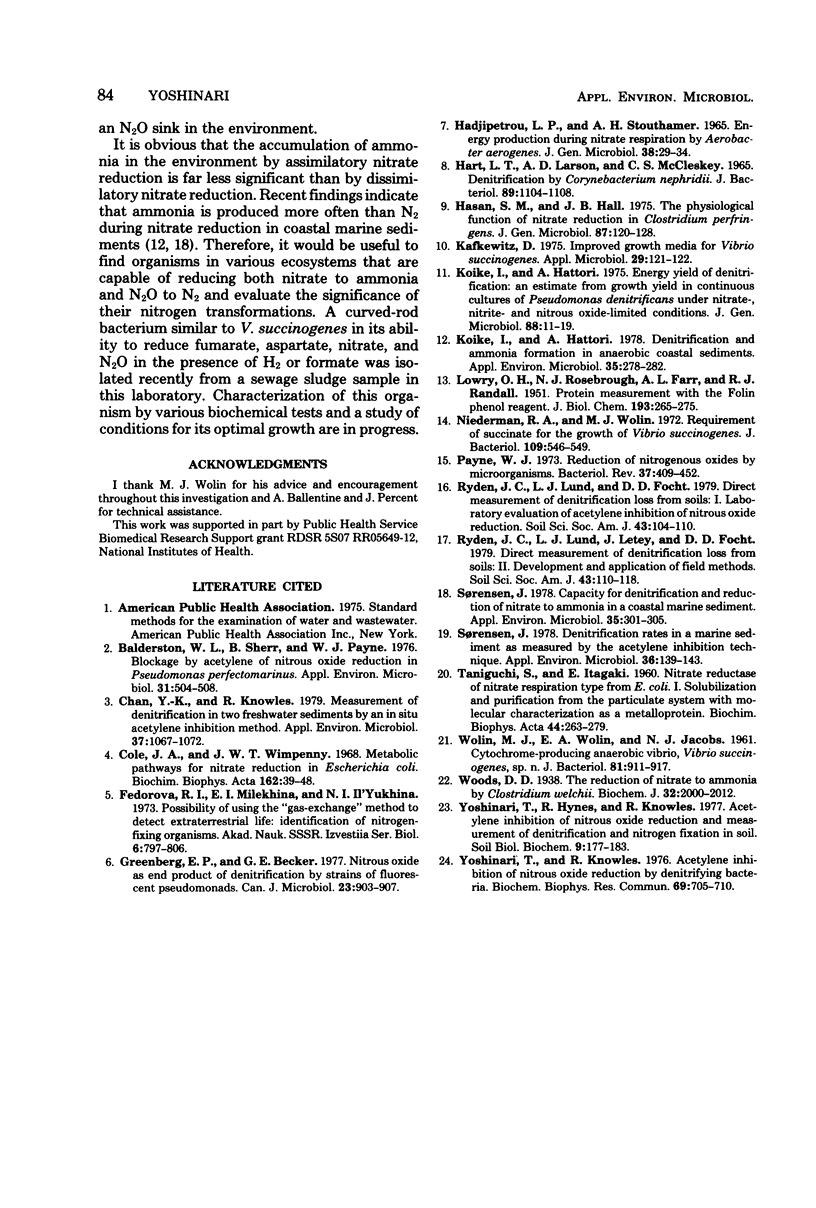Abstract
Vibrio succinogenes grew anaerobically at the expense of formate oxidation, with nitrous oxide (N2O) serving a terminal oxidant. N2O was quantitatively reduced to dinitrogen (N2). In the presence of 5 x 10(-2) atm (ca. 5 kPa) of acetylene (C2H2), which inhibits the reduction of N2O, growth of V. succinogenes was completely inhibited. Nitrate was reduced to nitrite or to ammonia, depending on the extent of availability of formate, but N2 was not produced by reduction of nitrate. During the reduction of nitrate to ammonia, all eight electrons transported to a molecule of nitrate appeared to be coupled for energy-yielding reactions.
Full text
PDF



Selected References
These references are in PubMed. This may not be the complete list of references from this article.
- Balderston W. L., Sherr B., Payne W. J. Blockage by acetylene of nitrous oxide reduction in Pseudomonas perfectomarinus. Appl Environ Microbiol. 1976 Apr;31(4):504–508. doi: 10.1128/aem.31.4.504-508.1976. [DOI] [PMC free article] [PubMed] [Google Scholar]
- Chan Y. K., Knowles R. Measurement of denitrification in two freshwater sediments by an in situ acetylene inhibition method. Appl Environ Microbiol. 1979 Jun;37(6):1067–1072. doi: 10.1128/aem.37.6.1067-1072.1979. [DOI] [PMC free article] [PubMed] [Google Scholar]
- Cole J. A., Wimpenny J. W. Metabolic pathways for nitrate reduction in Escherichia coli. Biochim Biophys Acta. 1968 Jul 16;162(1):39–48. doi: 10.1016/0005-2728(68)90212-0. [DOI] [PubMed] [Google Scholar]
- Fedorova R. I., Milekhina E. I., Il'iukhina N. I. O vozmozhnosti metoda "gazoobmena" dlia obnaruzheniia zhizni vne zemli--identifikatsiia azotfiksiruiushchikh mikroorganizmov. Izv Akad Nauk SSSR Biol. 1973 Nov-Dec;6:797–806. [PubMed] [Google Scholar]
- Greenberg E. P., Becker G. E. Nitrous oxide as end product of denitrification by strains of fluorescent pseudomonads. Can J Microbiol. 1977 Jul;23(7):903–907. doi: 10.1139/m77-133. [DOI] [PubMed] [Google Scholar]
- HADJIPETROU L. P., STOUTHAMER A. H. ENERGY PRODUCTION DURING NITRATE RESPIRATION BY AEROBACTER AEROGENES. J Gen Microbiol. 1965 Jan;38:29–34. doi: 10.1099/00221287-38-1-29. [DOI] [PubMed] [Google Scholar]
- HART L. T., LARSON A. D., MCCLESKEY C. S. DENITRIFICATION BY CORYNEBACTERIUM NEPHRIDII. J Bacteriol. 1965 Apr;89:1104–1108. doi: 10.1128/jb.89.4.1104-1108.1965. [DOI] [PMC free article] [PubMed] [Google Scholar]
- Hasan S. M., Hall J. B. The physiological function of nitrate reduction in Clostridium perfringens. J Gen Microbiol. 1975 Mar;87(1):120–128. doi: 10.1099/00221287-87-1-120. [DOI] [PubMed] [Google Scholar]
- Kafkewitz D. Improved growth media for Vibrio succinogenes. Appl Microbiol. 1975 Jan;29(1):121–122. doi: 10.1128/am.29.1.121-122.1975. [DOI] [PMC free article] [PubMed] [Google Scholar]
- Koike I., Hattori A. Denitrification and ammonia formation in anaerobic coastal sediments. Appl Environ Microbiol. 1978 Feb;35(2):278–282. doi: 10.1128/aem.35.2.278-282.1978. [DOI] [PMC free article] [PubMed] [Google Scholar]
- Koike I., Hattori A. Energy yield of denitrification: an estimate from growth yield in continuous cultures of Pseudomonas denitrificans under nitrate-, nitrite- and oxide-limited conditions. J Gen Microbiol. 1975 May;88(1):11–19. doi: 10.1099/00221287-88-1-11. [DOI] [PubMed] [Google Scholar]
- LOWRY O. H., ROSEBROUGH N. J., FARR A. L., RANDALL R. J. Protein measurement with the Folin phenol reagent. J Biol Chem. 1951 Nov;193(1):265–275. [PubMed] [Google Scholar]
- Niederman R. A., Wolin M. J. Requirement of succinate for the growth of Vibrio succinogenes. J Bacteriol. 1972 Feb;109(2):546–549. doi: 10.1128/jb.109.2.546-549.1972. [DOI] [PMC free article] [PubMed] [Google Scholar]
- Payne W. J. Reduction of nitrogenous oxides by microorganisms. Bacteriol Rev. 1973 Dec;37(4):409–452. doi: 10.1128/br.37.4.409-452.1973. [DOI] [PMC free article] [PubMed] [Google Scholar]
- Sørensen J. Capacity for denitrification and reduction of nitrate to ammonia in a coastal marine sediment. Appl Environ Microbiol. 1978 Feb;35(2):301–305. doi: 10.1128/aem.35.2.301-305.1978. [DOI] [PMC free article] [PubMed] [Google Scholar]
- Sørensen J. Denitrification rates in a marine sediment as measured by the acetylene inhibition technique. Appl Environ Microbiol. 1978 Jul;36(1):139–143. doi: 10.1128/aem.36.1.139-143.1978. [DOI] [PMC free article] [PubMed] [Google Scholar]
- TANIGUCHI S., ITAGAKI E. Nitrate reductase of nitrate respiration type from E. coli. I. Solubilization and purification from the particulate system with molecular characterization as a metalloprotein. Biochim Biophys Acta. 1960 Nov 4;44:263–279. doi: 10.1016/0006-3002(60)91562-6. [DOI] [PubMed] [Google Scholar]
- WOLIN M. J., WOLIN E. A., JACOBS N. J. Cytochrome-producing anaerobic Vibrio succinogenes, sp. n. J Bacteriol. 1961 Jun;81:911–917. doi: 10.1128/jb.81.6.911-917.1961. [DOI] [PMC free article] [PubMed] [Google Scholar]
- Woods D. D. The reduction of nitrate to ammonia by Clostridium welchii. Biochem J. 1938 Nov;32(11):2000–2012. doi: 10.1042/bj0322000. [DOI] [PMC free article] [PubMed] [Google Scholar]
- Yoshinari T., Knowles R. Acetylene inhibition of nitrous oxide reduction by denitrifying bacteria. Biochem Biophys Res Commun. 1976 Apr 5;69(3):705–710. doi: 10.1016/0006-291x(76)90932-3. [DOI] [PubMed] [Google Scholar]


